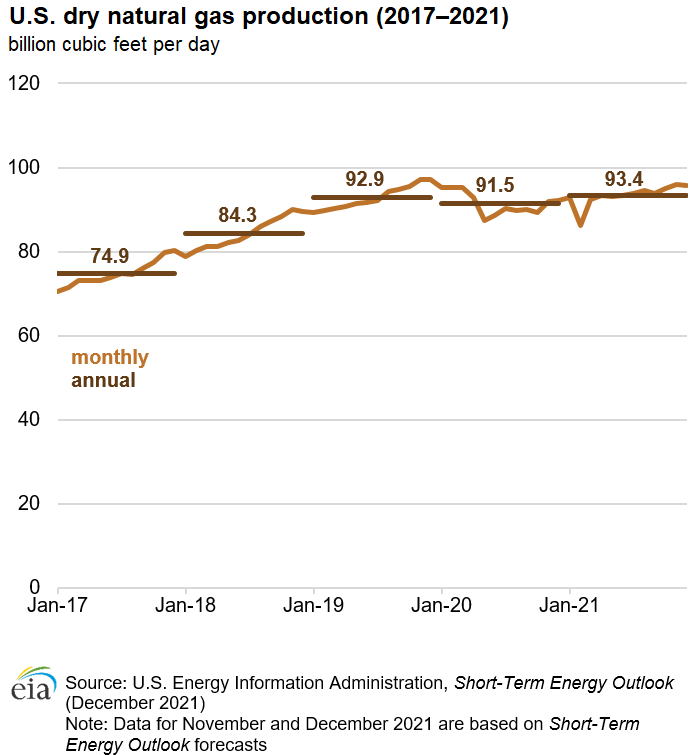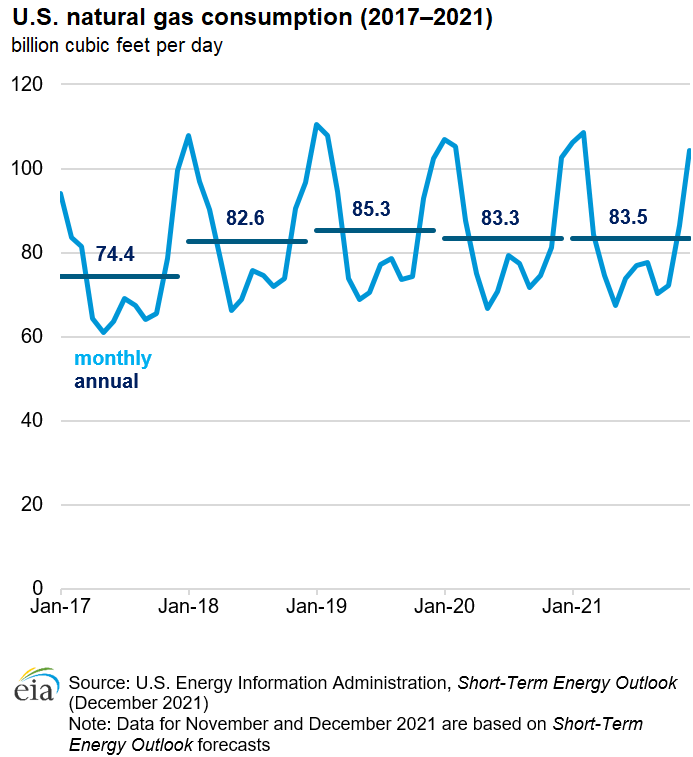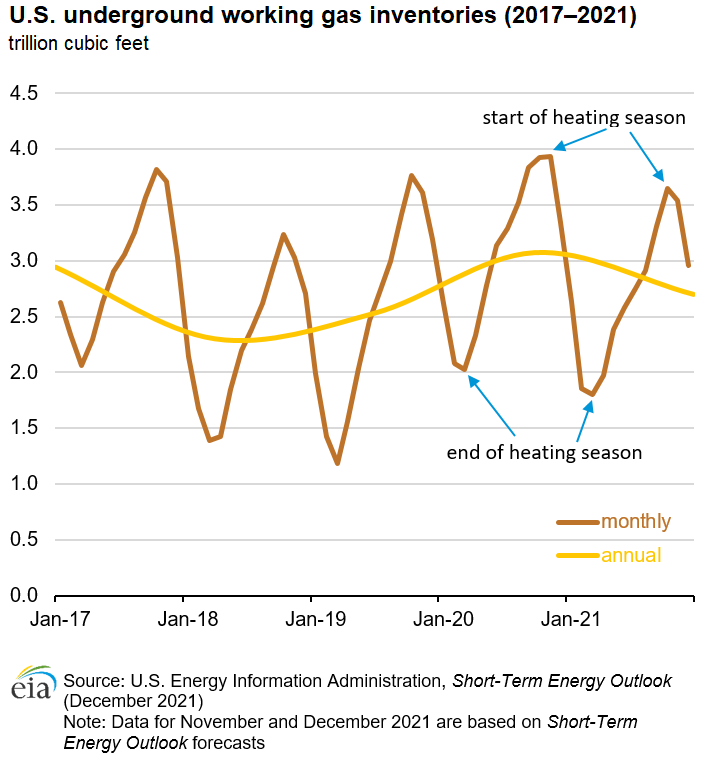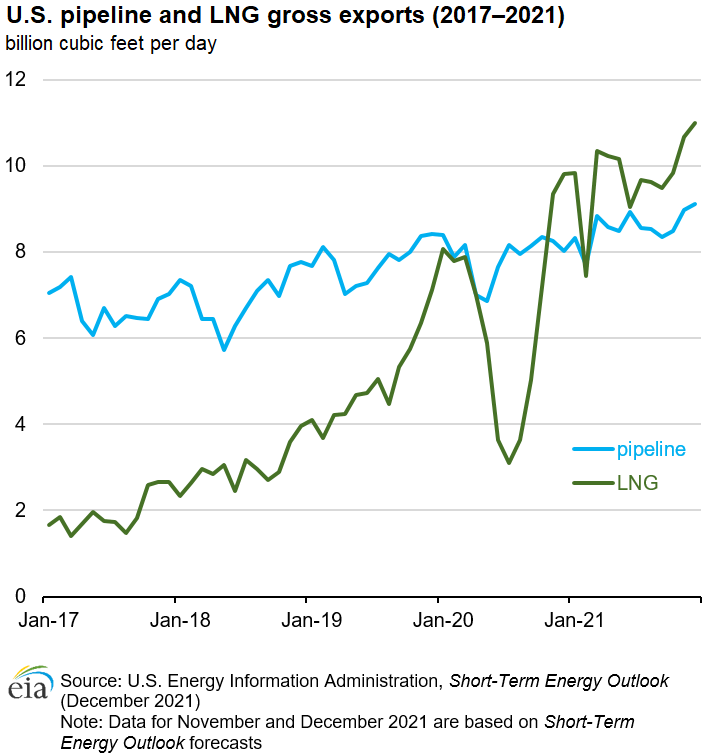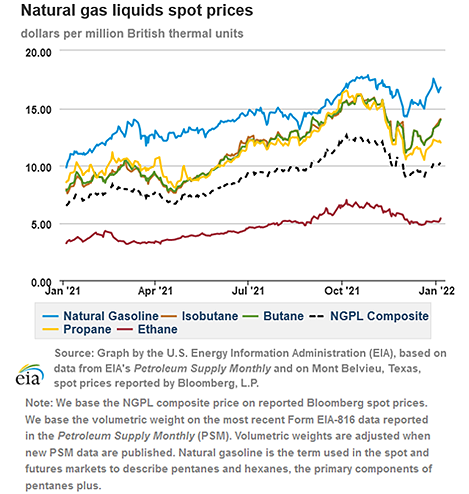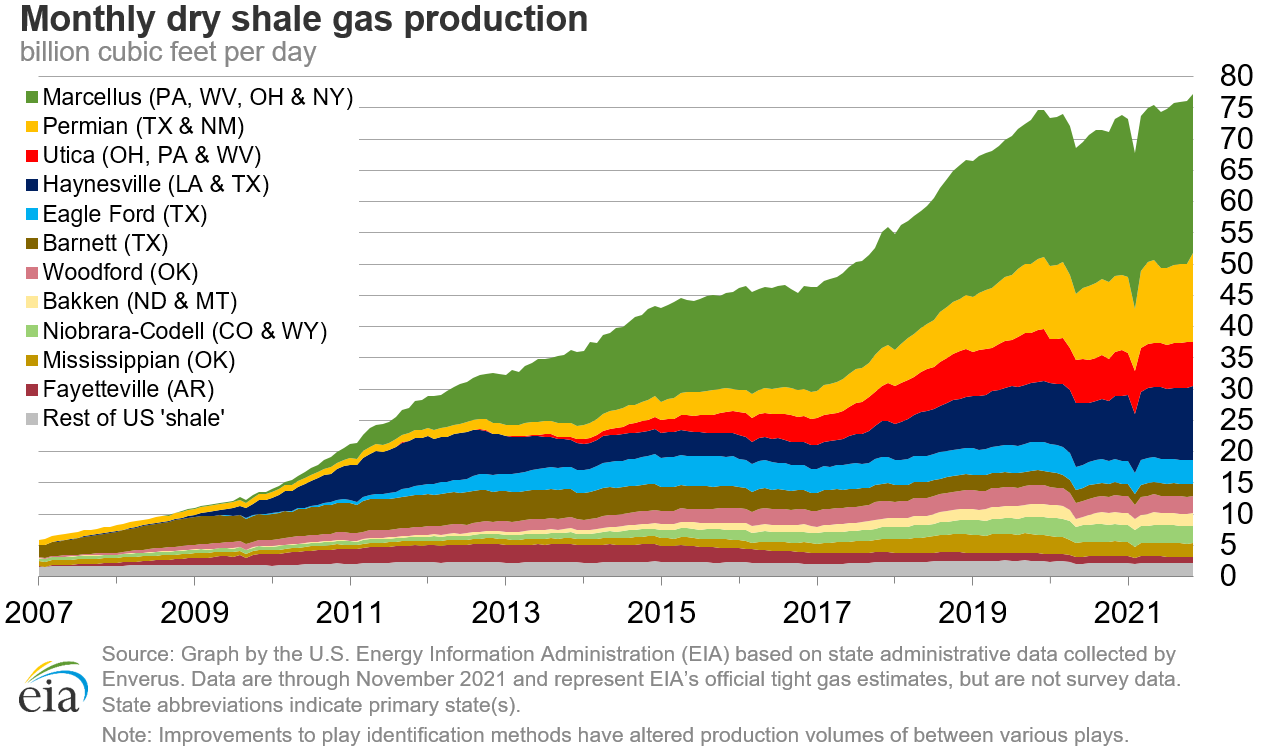In the News:
Highlights of 2021 U.S. natural gas
U.S. natural gas production, consumption, and exports increased in 2021, while net storage injections were lower than average.
EIA estimates that U.S. dry natural gas production averaged 93.4 billion cubic feet per day (Bcf/d) in 2021, exceeding the pre-pandemic high of 92.9 Bcf/d in 2019, according to our December Short-Term Energy Outlook (STEO). Growth in 2021 was led by increased natural gas production in the Appalachia, Permian, and Haynesville regions, and was the result of a variety of factors, including record levels of U.S. liquefied natural gas (LNG) exports, relatively higher natural gas prices, increased pipeline takeaway capacity, and reduced flaring. Annual growth in production occurred despite major interruptions, including the largest monthly decline in natural gas production on record in mid-February as a result of extremely cold weather, and a hurricane-related interruption in late August and early September. Freezing weather in February led to widespread well freeze-offs in producing regions, particularly in Texas.
U.S. natural gas consumption increased in 2021 compared with 2020, but it remained below the 2019 level. Natural gas consumption averaged 83.5 Bcf/d in 2021, up from 83.3 Bcf/d in 2020 but below the 2019 average of 85.3 Bcf/d, according to our December STEO. Consumption growth mainly occurred in the residential and commercial sectors (3.7% year-over-year increase in 2021) as a result of well-below-normal temperatures in the second half of the 2020–21 heating season. Industrial sector consumption of natural gas grew by 1.5% year over year, the result of increased industrial activity. Consumption of natural gas in the electric power sector declined by 3.3% compared with 2020, as a result of switching from natural gas to coal and competition from renewables as natural gas prices spiked in February and remained elevated for much of the year.
Natural gas storage inventories entered the 2021–22 winter heating season at the lowest level since 2018. At the end of March, traditionally considered the end of the heating season, natural gas inventories were 11% lower than in the same period in 2020. Strong natural gas demand during the 2020–21 heating season, combined with a reduction in natural gas production during this period, contributed to net withdrawals from storage exceeding the five-year average by 10.6%. With demand growth outpacing the growth in natural gas supply during the 2021 storage refill season (April through October), net injections of natural gas into storage in 2021 were 4% below the five-year average and 3% below the 2020 refill season.
For the third year in a row, U.S. natural gas gross exports reached new highs in 2021, driven primarily by growth in LNG exports. Both pipeline exports and LNG exports have been steadily increasing since 2015, and were higher in 2021 compared with 2020. Pipeline exports set a new monthly record in June, driven by increased exports to Mexico. Strong natural gas demand recovery in Asia (particularly in China), low natural gas storage levels in Europe, and high international natural gas prices supported record levels of U.S. LNG exports in 2021. We expect that growth in LNG exports will continue this year with additional export capacity expansions being placed in service between December 2021 and fall 2022, and by the end of 2022 U.S. LNG export capacity will exceed that of Australia and Qatar, the two largest LNG exporters currently.
Overview:
(For the week ending Wednesday, January 5, 2022)
- Natural gas spot prices rose at most locations this report week (Wednesday, December 29, to Wednesday, January 5). The Henry Hub spot price rose from $3.40 per million British thermal units (MMBtu) last Wednesday to $3.79/MMBtu yesterday.
- International natural gas prices fell this report week. Bloomberg Finance L.P. reports that swap prices for liquefied natural gas (LNG) cargos in East Asia for the balance of the month (January) fell $10.47 to a weekly average of $32.79/MMBtu, after setting a new weekly average price record high of $43.26/MMBtu in the previous week. At the Title Transfer Facility (TTF) in the Netherlands, the most liquid natural gas spot market in Europe, the day-ahead price declined for the second week in a row to a weekly average of $26.51/MMBtu. Weekly average prices at TTF set an all-time record high two weeks ago, reaching $51.18/MMBtu—the highest weekly average on record going back to September 2007. Daily prices that week set even higher records, reaching $60.29/MMBtu on December 21. In the same week last year (week ending January 6, 2021), prices in East Asia and at TTF were $14.24/MMBtu and $6.69/MMBtu, respectively.
- The price of the February 2022 NYMEX contract decreased 14.2 cents, from $4.024/MMBtu last Wednesday to $3.882/MMBtu yesterday. The price of the 12-month strip averaging February 2022 through January 2023 futures contracts climbed 2.9 cents to $3.839/MMBtu. The front end of the strip, comprising the remaining two months of the current winter, fell 14.1 cents, whereas futures contracts for delivery during the first five months of the 2022–23 winter rose 6.8 cents to an average of $4.018/MMBtu.
- The net withdrawals from working gas totaled 31 billion cubic feet (Bcf) for the week ending December 31. Working natural gas stocks totaled 3,195 Bcf, which is 5% lower than the year-ago level and 3% more than the five-year (2016–2020) average for this week.
- The natural gas plant liquids composite price at Mont Belvieu, Texas, rose by 18 cents/MMBtu, averaging $10.14/MMBtu for the week ending January 5. Natural gasoline prices fell 3%. Ethane prices rose 2%, while natural gas at the Houston Ship Channel rose 14%, narrowing the premium of ethane to natural gas by 16% for the week ending January 5. Propane prices rose 1% following a 1% increase in Brent crude oil prices. The propane discount to crude oil increased by 9 cents/MMBtu, widening the price spread by 7%, for the week ending January 5. Normal butane and isobutane prices rose 9% due to increased use of butanes for motor gasoline blending, which primarily occurs during the winter months when finished motor gasoline has a higher allowable vapor pressure.
- According to Baker Hughes, for the week ending Tuesday, December 28, the natural gas rig count was flat from a week ago at 106. From the last week of November to this report week, the natural gas rig count was up four rigs. The Eagle Ford gained one rig since then and the Haynesville added three rigs. The number of oil-directed rigs was also flat this week at 480, but is 13 rigs higher than in the last week of November. The largest change in the number of oil-directed rigs from the end of November was in the Permian Basin, where 13 rigs have been added in the last month. The total rig count now stands at 586, the highest level since April 9, 2020.
Prices/Supply/Demand:
Prices along the Gulf Coast rise in response to a sudden drop in temperatures and increasing demand for space heating. This report week (Wednesday, December 29, to Wednesday, January 5), the Henry Hub spot price rose 39 cents from a weekly low of $3.40/MMBtu last Wednesday to a weekly high of $3.79/MMBtu yesterday. Prices at the Houston Ship Channel also rose this report week, up 54 cents from $3.21/MMBtu last Wednesday to $3.75/MMBtu yesterday. Temperatures throughout the South declined rapidly this week. In Dallas/Fort Worth, the daily high fell from 73°F on Saturday (17°F above normal) to 40°F (16°F below normal) on Sunday. The rapid drop in temperatures resulted in natural gas demand in the region rising week over week. IHS Markit estimates for average weekly natural gas consumption in Texas rose by 1.9 Bcf/d (19%) this report week, led by a 1.1 Bcf/d increase in the residential and commercial sector. Production in inland Texas fell as a result of the low temperatures and well freeze-offs. IHS Markit estimates weekly average production in the Permian Basin in West Texas and Southeast New Mexico fell by 0.8 Bcf/d (5%) week over week. Lower feed gas deliveries to Gulf Coast LNG terminals offset some of the rise in regional demand. After reaching an all-time high in the report week ending December 22, averaging 11.3 Bcf/d, feed gas deliveries to Gulf Coast LNG export terminals fell to 11.2 Bcf/d in the last report week of December and to 10.7 Bcf/d this report week as a result of dense fog along the Gulf Coast, which reduced shipping activity in ports as far apart as Corpus Christi in Texas and the Sabine/Neches waterway in Louisiana.
A cold front across the Midwest this report week resulted in significantly higher natural gas consumption and rising prices throughout the region. At the Chicago Citygate, the natural gas price increased 93 cents from $3.50/MMBtu last Wednesday to a weekly high of $4.43/MMBtu yesterday. The price at Oneok Gas Transmission, the main delivery point for Oklahoma consumers, rose $1.47 from $3.20/MMBtu last Wednesday to $4.67/MMBtu yesterday. Temperatures in the region fell rapidly this report week. In the Chicago area, the daily average temperature rose to 38°F (11°F above normal) on Friday, December 31, and fell to 16°F (11°F below normal) on Monday, January 3. Daily average temperatures in Oklahoma City rose to nearly 53°F (15°F above normal) on Friday and then fell just shy of 21°F (17°F below normal) on Sunday. IHS Markit estimates for weekly average consumption in the Midcontinent rose by 5.5 Bcf/d, or approximately 28% week over week, to 25.0 Bcf/d, led by an increase in the residential and commercial sector, which rose by more than 4.3 Bcf/d. As in the South, production in the Midcontinent also fell, by approximately 0.5 Bcf/d, or 5%, with most of the losses coming from Oklahoma, where average weekly production declined by more than 0.3 Bcf/d as a result of well freeze-offs.
Prices in the West fall as a sustained cold spell ends and demand falls as a result of normal- to above-normal temperatures. The price at PG&E Citygate in Northern California fell $1.47, down from $6.84/MMBtu last Wednesday to $5.37/MMBtu yesterday, after dropping to a weekly low of $5.26/MMBtu on Tuesday. The price at SoCal Citygate in Southern California decreased $1.45 from $7.40/MMBtu last Wednesday to a weekly low of $5.95/MMBtu yesterday. After two weeks of sustained below-normal temperatures, temperatures across the West rose to above-average levels this report week. In Riverside, California, inland from Los Angeles, a prolonged cold spell came to an end yesterday, when temperatures averaged 56°F (1°F above normal), the first time temperatures rose above normal since December 22. IHS Markit estimates consumption in California fell slightly by 30 million cubic feet per day (MMcf/d) on average this week, as a result of less consumption in the electric power sector and in the residential and commercial sector. Recent heavy precipitation in the region replenished reservoirs, allowing for the restart of power generation at the Hyatt Power Plant on Lake Oroville in California, which stopped generating electricity in August as a result of record-low reservoir levels behind the dam. Total natural gas consumption in the Pacific Northwest also fell, by approximately 130 MMcf/d week over week. Supply into Southern California remains impaired by a continuing outage on the El Paso Natural Gas (EPNG) pipeline. In its latest Maintenance Update for EPNG, Kinder Morgan, operator of the pipeline, reports flows on Line 2000 through the Cimarron compressor station will remain at zero through the end of January, compared with segment capacity of 600 MMcf/d.
Prices in the Northeast rise as a result of pipeline constraints and high space heating demand. At the Algonquin Citygate, which serves Boston-area consumers, the price went up $7.78 from $3.78/MMBtu last Wednesday to a weekly high of $11.56/MMBtu yesterday. At the Transcontinental Pipeline Zone 6 trading point for New York City, the price increased $5.16 from $2.50/MMBtu last Wednesday to a weekly high $7.66/MMBtu yesterday. Winter weather swept through the Northeast starting on New Year’s Day, and temperatures across New England ranged from averages of 11°F to 30°F on the two coldest days, January 3 and 4. Total Northeast natural gas consumption reached a heating-season high of 30.6 Bcf/d on January 3, according to IHS Markit. Imports from Canada were also up, reaching 1.4 Bcf/d on January 3.
Tennessee Gas Pipeline (TGP) completed an emergency repair at Station 325 near Liberty, New Jersey, (Notice ID No. 381406) on January 2. TGP estimated the impact of the repair to be about 180 MMcf/d, and the issue was resolved the next day.
Prices in the Appalachia production region rise in response to higher demand in the Midwest and Northeast, and a slight fall in production. The Tennessee Zone 4 Marcellus spot price increased 90 cents from $2.42/MMBtu last Wednesday to $3.32/MMBtu yesterday. The price at Eastern Gas South in southwest Pennsylvania rose $1.06 from $2.32/MMBtu last Wednesday to $3.38/MMBtu yesterday. Natural gas production in the Appalachia region is down 0.6 Bcf/d this report week at 34.6 Bcf/d from 35.2 Bcf/d last week.
The price discount in the Permian Basin production region relative to the Henry Hub price declines this report week as a result of lower production in the region. The price at the Waha Hub in West Texas, which is located near Permian Basin production activities, rose 81 cents this report week, from $2.95/MMBtu last Wednesday to $3.76/MMBtu yesterday. The Waha Hub traded 3 cents below the Henry Hub price yesterday, compared with last Wednesday when it traded 45 cents below the Henry Hub price. Low temperatures in West Texas and Southeast New Mexico resulted in well freeze-offs, reducing production in the region by approximately 5% week over week (see Gulf Coast section for more detail).
U.S. total natural gas supply falls week-over-week with a decrease in dry natural gas production. According to data from IHS Markit, the average total supply of natural gas fell by 1.5% (1.5 Bcf/d) from a week ago. Dry natural gas production decreased by 2.7% (2.6 Bcf/d), but the decline in total supply was partially offset by average net imports from Canada increasing by 28.5% (1.1 Bcf/d) across the same time period.
U.S. consumption of natural gas substantially increases this report week across all sectors. U.S. residential and commercial sector consumption increased by 21.8% (7.6 Bcf/d) as the National Oceanic and Atmospheric Administration (NOAA) reports widespread, below-average temperatures across the central and western United States. As a result, total U.S. consumption of natural gas increased by 13.3% (11.1 Bcf/d) week over week, according to data from IHS Markit. Natural gas consumption by the electric power and industrial sectors also increased significantly, rising respectively by 9.6% (2.4 Bcf/d) and 4.5% (1.1 Bcf/d), week over week. Natural gas exports to Mexico increased 2.3% (0.1 Bcf/d), while natural gas deliveries to U.S. LNG export facilities (LNG pipeline receipts) declined, averaging 11.9 Bcf/d, or 0.5 Bcf/d lower than last week.
U.S. LNG exports increased by three vessels this week from last week. Twenty-four LNG vessels (seven from Sabine Pass, five each from Corpus Christi and Freeport, four from Cameron, two from Cove Point, and one from Elba Island) with a combined LNG-carrying capacity of 88 Bcf departed the United States between December 30, 2021, and January 5, 2022, according to shipping data provided by Bloomberg Finance L.P.
Storage:
The net withdrawals from storage totaled 31 Bcf for the week ending December 31, compared with the five-year (2016–2020) average net withdrawals of 108 Bcf and last year's net withdrawals of 127 Bcf during the same week. Working natural gas stocks totaled 3,195 Bcf, which is 96 Bcf more than the five-year average and 154 Bcf lower than last year at this time.
According to The Desk survey of natural gas analysts, estimates of the weekly net change to working natural gas stocks ranged from net withdrawals of 27 Bcf to 74 Bcf, with a median estimate of 49 Bcf.
More storage data and analysis can be found on the Natural Gas Storage Dashboard and the Weekly Natural Gas Storage Report.
See also:
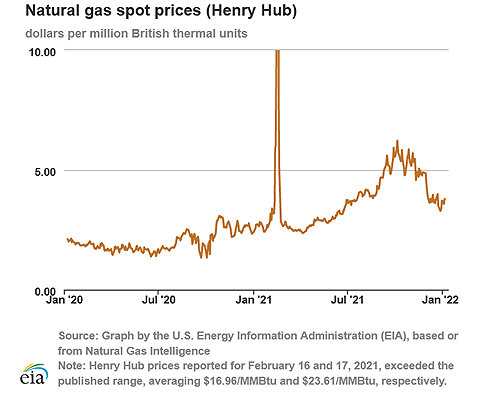
| Spot Prices ($/MMBtu) | Thu, 30-Dec |
Fri, 31-Dec |
Mon, 3-Jan |
Tue, 4-Jan |
Wed, 5-Jan |
|---|---|---|---|---|---|
| Henry Hub | 3.72 | CLOSED | 3.58 | 3.76 | 3.79 |
| New York | 3.54 | CLOSED | 8.50 | 5.62 | 7.66 |
| Chicago | 3.67 | CLOSED | 3.47 | 3.87 | 4.43 |
| Cal. Comp. Avg,* | 7.09 | CLOSED | 5.66 | 5.32 | 5.35 |
| Futures ($/MMBtu) | |||||
| February Contract | 3.561 | 3.730 | 3.815 | 3.717 | 3.882 |
| March Contract | 3.435 | 3.557 | 3.678 | 3.582 | 3.710 |
| *Avg. of NGI's reported prices for: Malin, PG&E Citygate, and Southern California Border Avg. | |||||
| Source: NGI's Daily Gas Price Index | |||||
| Spot Prices ($/MMBtu) | Thu, 23-Dec |
Fri, 24-Dec |
Mon, 27-Dec |
Tue, 28-Dec |
Wed, 29-Dec |
|---|---|---|---|---|---|
| Henry Hub | 3.52 | HOLIDAY | 3.30 | 3.30 | 3.40 |
| New York | 2.62 | HOLIDAY | 2.80 | 2.57 | 2.50 |
| Chicago | 3.41 | HOLIDAY | 3.38 | 3.55 | 3.50 |
| Cal. Comp. Avg,* | 6.62 | HOLIDAY | 7.28 | 7.54 | 6.77 |
| Futures ($/MMBtu) | |||||
| January Contract | 3.731 | HOLIDAY | 4.060 | 4.055 | 4.024 |
| February Contract | 3.630 | HOLIDAY | 3.942 | 3.885 | 3.850 |
| *Avg. of NGI's reported prices for: Malin, PG&E Citygate, and Southern California Border Avg. | |||||
| Source: NGI's Daily Gas Price Index | |||||
| Spot Prices ($/MMBtu) | Thu, 16-Dec |
Fri, 17-Dec |
Mon, 20-Dec |
Tue, 21-Dec |
Wed, 22-Dec |
|---|---|---|---|---|---|
| Henry Hub | 3.68 | 3.62 | 3.88 | 3.92 | 3.99 |
| New York | 2.90 | 3.93 | 4.00 | 4.82 | 4.18 |
| Chicago | 3.61 | 3.50 | 3.74 | 3.72 | 3.76 |
| Cal. Comp. Avg,* | 5.29 | 5.43 | 6.77 | 6.47 | 7.97 |
| Futures ($/MMBtu) | |||||
| January Contract | 3.766 | 3.69 | 3.834 | 3.869 | 3.976 |
| February Contract | 3.715 | 3.64 | 3.758 | 3.774 | 3.860 |
| *Avg. of NGI's reported prices for: Malin, PG&E Citygate, and Southern California Border Avg. | |||||
| Source: NGI's Daily Gas Price Index | |||||
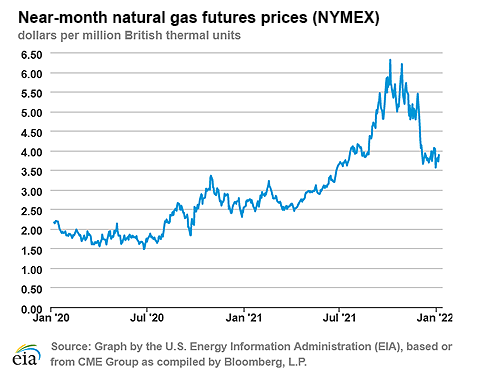
| U.S. natural gas supply - Gas Week: (12/30/21 - 1/5/22) | |||
|---|---|---|---|
Average daily values (billion cubic feet) |
|||
this week |
last week |
last year |
|
| Marketed production | 106.0 |
109.0 |
103.6 |
| Dry production | 94.3 |
97.0 |
92.3 |
| Net Canada imports | 4.8 |
3.7 |
6.0 |
| LNG pipeline deliveries | 0.2 |
0.1 |
0.2 |
| Total supply | 99.3 |
100.8 |
98.6 |
|
Source: Chart by the U.S. Energy Information Administration (EIA), based on data from IHS Markit | |||
| U.S. natural gas consumption - Gas Week: (12/30/21 - 1/5/22) | |||
|---|---|---|---|
Average daily values (billion cubic feet) |
|||
this week |
last week |
last year |
|
| U.S. consumption | 95.0 |
83.8 |
93.7 |
| Power | 27.6 |
25.2 |
27.2 |
| Industrial | 24.8 |
23.7 |
25.1 |
| Residential/commercial | 42.6 |
34.9 |
41.4 |
| Mexico exports | 4.8 |
4.7 |
4.9 |
| Pipeline fuel use/losses | 7.2 |
7.0 |
7.1 |
| LNG pipeline receipts | 11.9 |
12.4 |
11.0 |
| Total demand | 119.0 |
107.9 |
116.7 |
|
Source: Chart by the U.S. Energy Information Administration (EIA), based on data from IHS Markit | |||
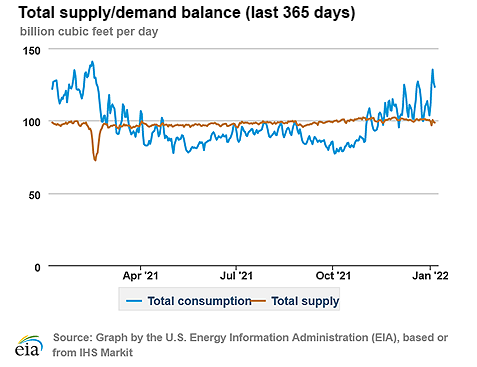
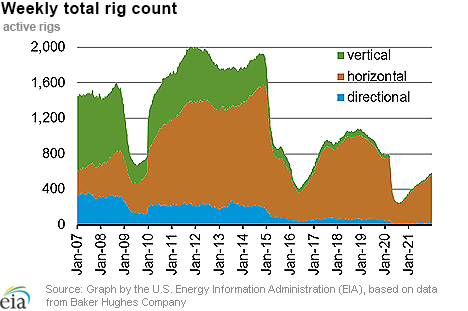
| Rigs | |||
|---|---|---|---|
Tue, December 28, 2021 |
Change from |
||
last week |
last year |
||
| Oil rigs | 480 |
0.0% |
79.8% |
| Natural gas rigs | 106 |
0.0% |
27.7% |
| Note: Excludes any miscellaneous rigs | |||
| Rig numbers by type | |||
|---|---|---|---|
Tue, December 28, 2021 |
Change from |
||
last week |
last year |
||
| Vertical | 26 |
-3.7% |
52.9% |
| Horizontal | 530 |
0.4% |
69.3% |
| Directional | 30 |
-3.2% |
42.9% |
| Source: Chart by the U.S. Energy Information Administration (EIA), based on data from Baker Hughes Company | |||
| Working gas in underground storage | ||||
|---|---|---|---|---|
Stocks billion cubic feet (Bcf) |
||||
| Region | 2021-12-31 |
2021-12-24 |
change |
|
| East | 767 |
777 |
-10 |
|
| Midwest | 893 |
918 |
-25 |
|
| Mountain | 172 |
180 |
-8 |
|
| Pacific | 219 |
235 |
-16 |
|
| South Central | 1,143 |
1,116 |
27 |
|
| Total | 3,195 |
3,226 |
-31 |
|
|
Source: U.S. Energy Information Administration Form EIA-912, Weekly Underground Natural Gas Storage Report | ||||
| Working gas in underground storage | |||||
|---|---|---|---|---|---|
Historical comparisons |
|||||
Year ago (12/31/20) |
5-year average (2017-2021) |
||||
| Region | Stocks (Bcf) |
% change |
Stocks (Bcf) |
% change |
|
| East | 771 |
-0.5 |
728 |
5.4 |
|
| Midwest | 930 |
-4.0 |
873 |
2.3 |
|
| Mountain | 197 |
-12.7 |
178 |
-3.4 |
|
| Pacific | 283 |
-22.6 |
256 |
-14.5 |
|
| South Central | 1,166 |
-2.0 |
1,063 |
7.5 |
|
| Total | 3,349 |
-4.6 |
3,099 |
3.1 |
|
| Source: U.S. Energy Information Administration Form EIA-912, Weekly Underground Natural Gas Storage Report | |||||
| Temperature – heating & cooling degree days (week ending Dec 30) | ||||||||
|---|---|---|---|---|---|---|---|---|
HDDs |
CDDs |
|||||||
| Region | Current total |
Deviation from normal |
Deviation from last year |
Current total |
Deviation from normal |
Deviation from last year |
||
| New England | 224 |
-35 |
26 |
0 |
0 |
0 |
||
| Middle Atlantic | 182 |
-65 |
-22 |
0 |
0 |
0 |
||
| E N Central | 184 |
-97 |
-74 |
0 |
0 |
0 |
||
| W N Central | 240 |
-65 |
-44 |
0 |
0 |
0 |
||
| South Atlantic | 78 |
-97 |
-96 |
11 |
5 |
8 |
||
| E S Central | 47 |
-133 |
-131 |
7 |
6 |
7 |
||
| W S Central | 22 |
-113 |
-76 |
29 |
27 |
26 |
||
| Mountain | 225 |
-10 |
1 |
0 |
0 |
0 |
||
| Pacific | 163 |
38 |
36 |
0 |
0 |
0 |
||
| United States | 156 |
-61 |
-41 |
6 |
5 |
5 |
||
|
Source: Chart by the U.S. Energy Information Administration (EIA), based on data from the National Oceanic and Atmospheric Administration Note: HDDs=heating degree days; CDDs=cooling degree days | ||||||||
Average temperature (°F)
7-day mean ending Dec 30, 2021
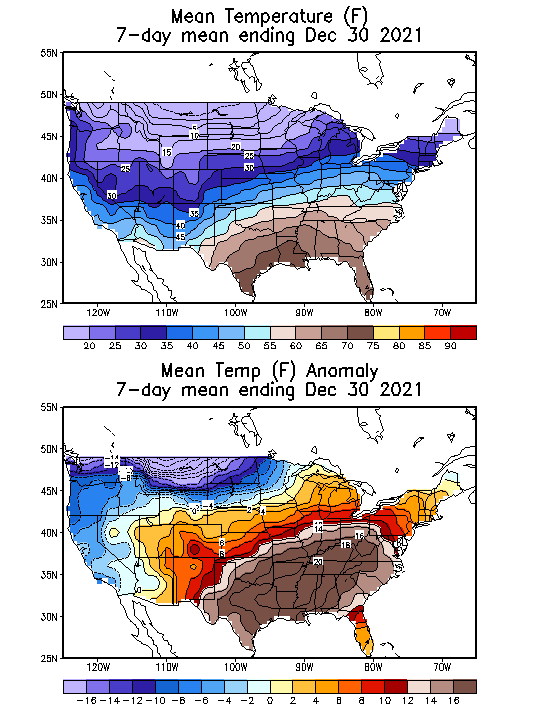
Source: National Oceanic and Atmospheric Administration
Deviation between average and normal (°F)
7-day mean ending Dec 30, 2021

Source: National Oceanic and Atmospheric Administration

